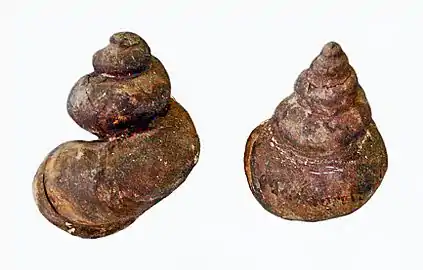Holopea
Holopea is an extinct genus of fossil sea snails, Paleozoic gastropod mollusks in the family Holopeidae.
| Holopea | |
|---|---|
 | |
| Holopea praestans from Czech Republic, at the National Museum (Prague) | |
| Scientific classification | |
| Kingdom: | |
| Phylum: | |
| Class: | |
| Family: | |
| Genus: | †Holopea |
| Synonyms | |
|
Cirropsis Perner, 1903 | |
These molluscs were stationary epifaunal suspension feeders. They lived in the Paleozoic Era, Ordovician Period, upper Arenigian age (between 478.6 ± 1.7 and 471.8 ± 1.6 million years ago) to the Carboniferous period, lower Serpukhovian age (from 328.3 (± 1.6) Ma to 318.1 (± 1.3) mya).
Distribution
These fossil gastropods are found in: the Permian of China; the Devonian of Australia, Canada, United States; the Silurian of Australia, Canada, Russia, Sweden, United Kingdom, United States; the Ordovician of Canada, China, the Czech Republic, Estonia, Iran, New Zealand, Norway, Sweden, the United Kingdom, United States; Chazy of Canada; Arenig of Greenland.
References
- J. Hall. 1847. Containing descriptions of the organic remains of the lower division of the New York system (equivalent of the Lower Silurian rocks of Europe). Paleontology of New York 1:1-338
- Paleobiology Database
- Sepkoski, Jack Sepkoski's Online Genus Database